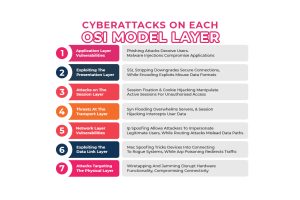OSI Model
The OSI (Open Systems Interconnection) model is a conceptual framework used to understand and standardize network communications. These layers describe how data is transmitted from one device to another, ensuring seamless communication in a networked world. Understanding the OSI model and cyberattacks against its layers is essential to identifying vulnerabilities and implementing effective security measures.
Why is the OSI Model Important in Networking?
By breaking down networking into manageable layers, the OSI model simplifies troubleshooting, design, and security. It provides a common language for understanding complex networking systems.
Cybersecurity and the OSI Model Connection
Each OSI layer presents unique security challenges, making it a crucial focus for cybersecurity professionals. Attackers exploit vulnerabilities at various layers of the OSI model, necessitating a deep understanding of the model to implement robust defenses against cyberattacks.
Cyberattacks on Each OSI Model Layer

Attacks Targeting the Physical Layer
Wiretapping and jamming disrupt hardware functionality, compromising connectivity.
Exploiting the Data Link Layer
MAC spoofing tricks devices into connecting to rogue systems, while ARP poisoning redirects traffic.
Network Layer Vulnerabilities
IP spoofing allows attackers to impersonate legitimate users, while routing attacks mislead data paths.
Threats at the Transport Layer
SYN flooding overwhelms servers, and session hijacking intercepts user data.
Attacks on the Session Layer
Session fixation and cookie hijacking manipulate active sessions for unauthorized access.
Exploiting the Presentation Layer
SSL stripping downgrades secure connections while encoding exploits misuse data formats.
Application Layer Vulnerabilities
Phishing attacks deceive users. Malware injections compromise applications.
Key Strategies for Protecting Each Layer
- Securing the Physical Layer: Use secure facilities and access control mechanisms.
- Safeguarding the Data Link Layer: Deploy VLANs and monitor traffic for anomalies.
- Defending the Network Layer: Implement firewalls and use secure routing protocols.
- Protecting the Transport Layer: Use encryption and secure handshake protocols.
- Mitigating Session Layer Risks: Manage session tokens securely and validate inputs.
- Enhancing Presentation Layer Security: Deploy up-to-date SSL/TLS protocols.
- Strengthening Application Layer Defenses: Regularly patch software and educate users on threats.
The Importance of Layered Security in Cyber Defense
How Layered Security Works
Layered security combines multiple defenses to protect all aspects of a system.
Benefits of a Layered Approach
It minimizes vulnerabilities, prevents attacks at various levels, and ensures comprehensive protection. With the rise of AI-powered threats and quantum computing, cybersecurity measures must evolve to address these advanced challenges.
Conclusion
The OSI model provides a structured approach to understanding and addressing cybersecurity. Protecting each layer is vital for a secure networking environment. By adopting a layered defense strategy, organizations can effectively counteract cyber threats.
FAQS
To standardize networking functions and ensure interoperability among different systems.
The Application Layer is highly targeted due to direct interaction with users and applications.
By securing hardware components in controlled environments and using surveillance.
Encryption safeguards data in transit and storage, particularly at the Transport and Presentation layers.
Not all, but many align with specific layers, highlighting the importance of layered security.



